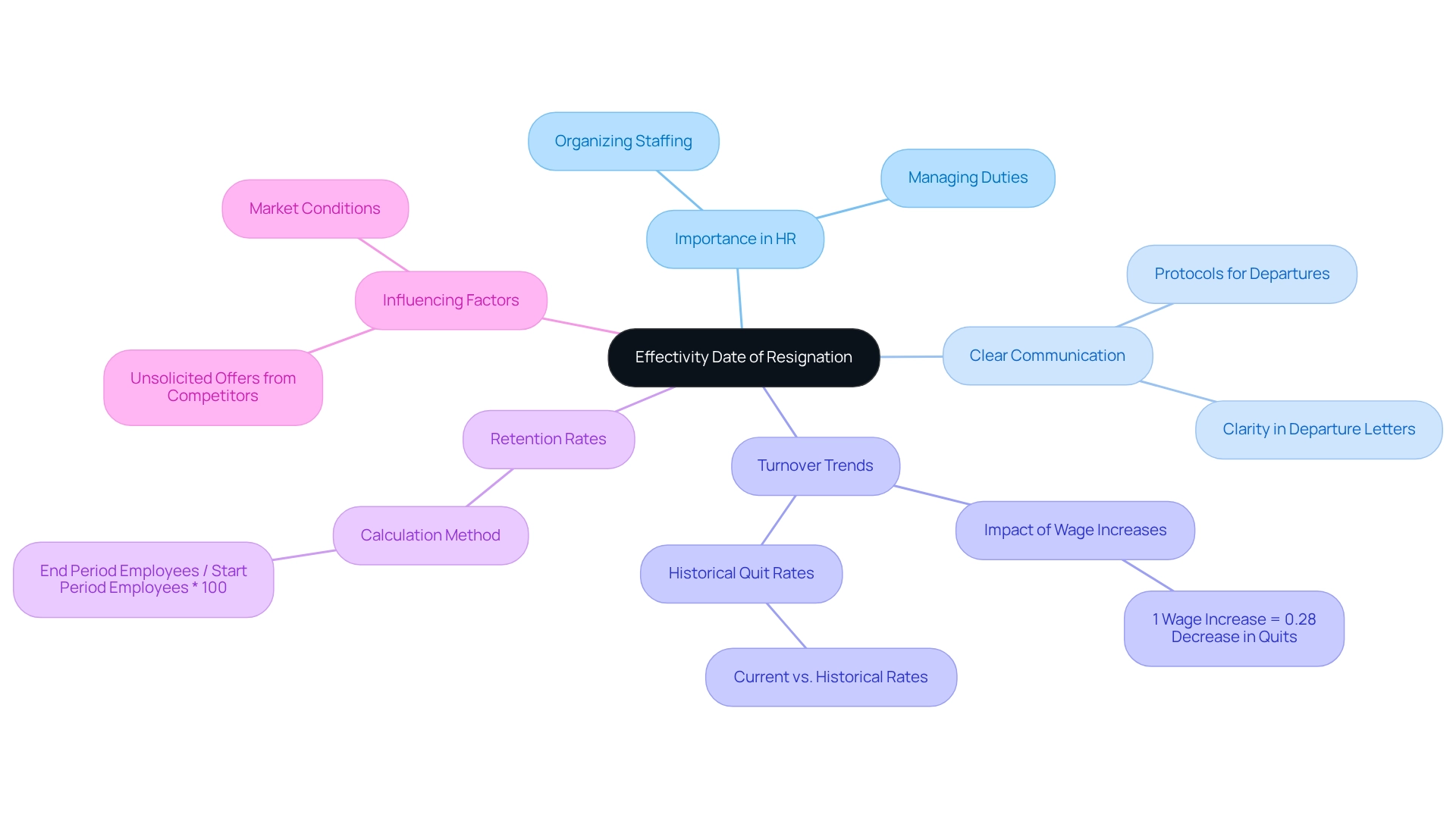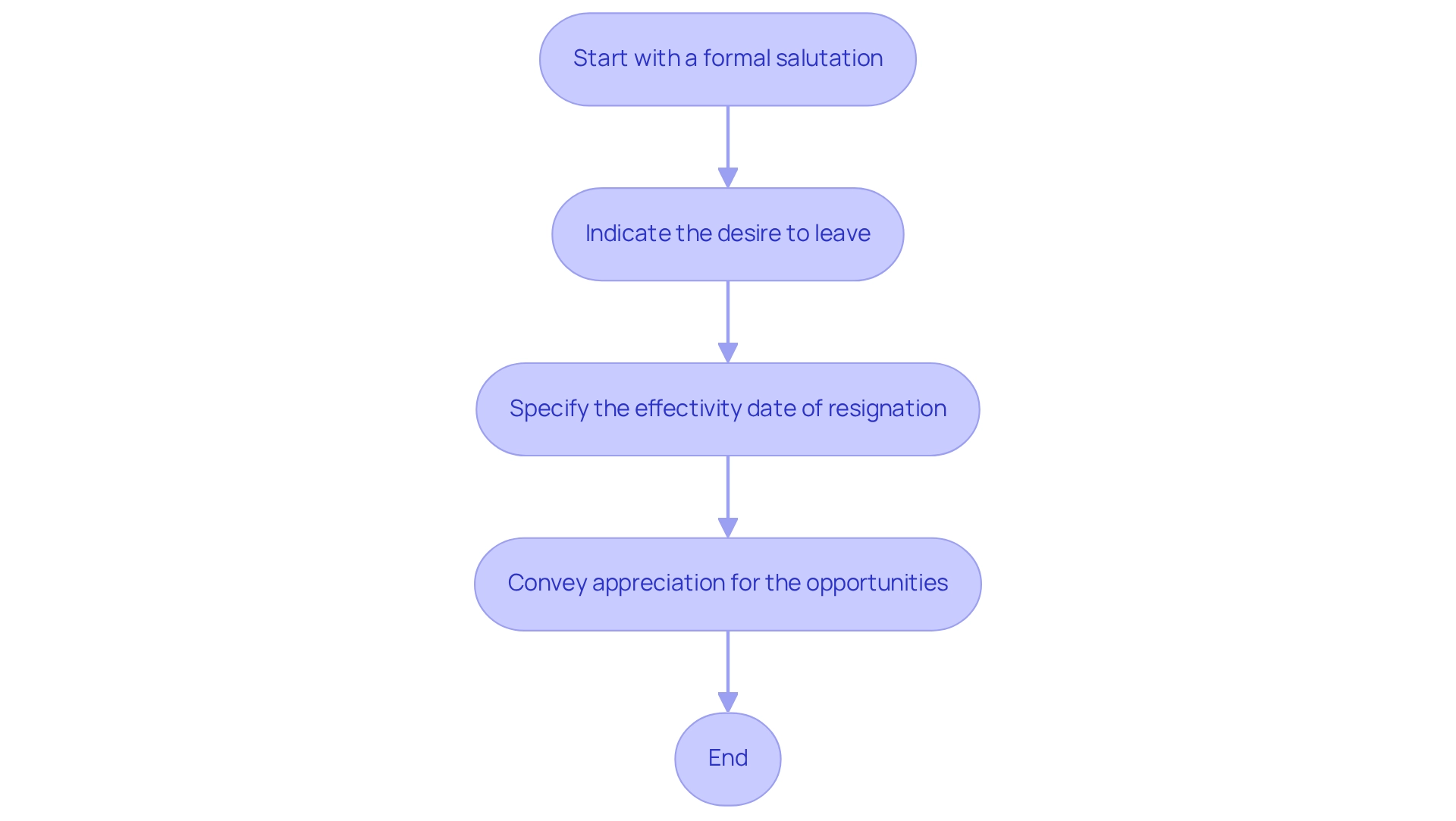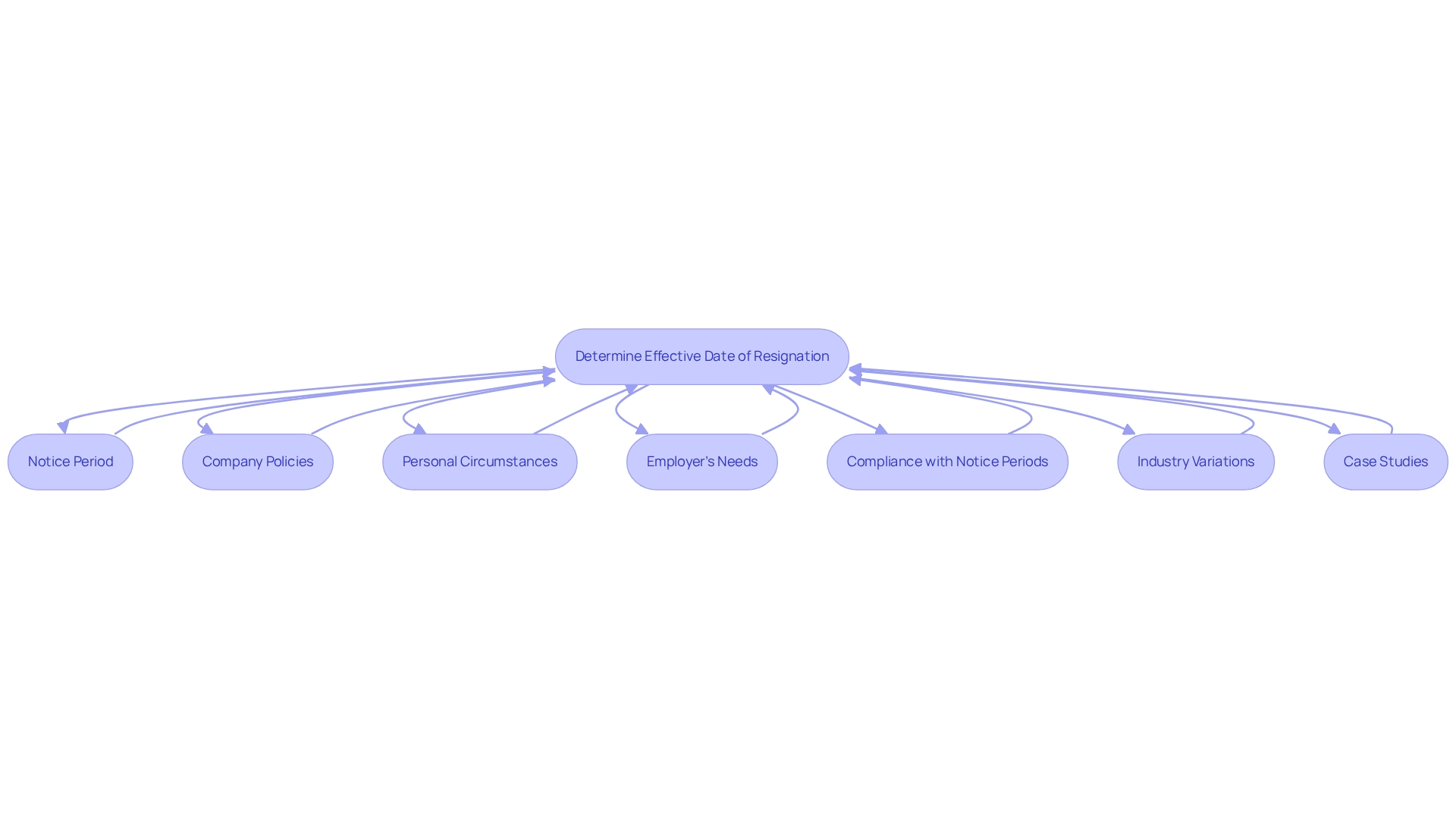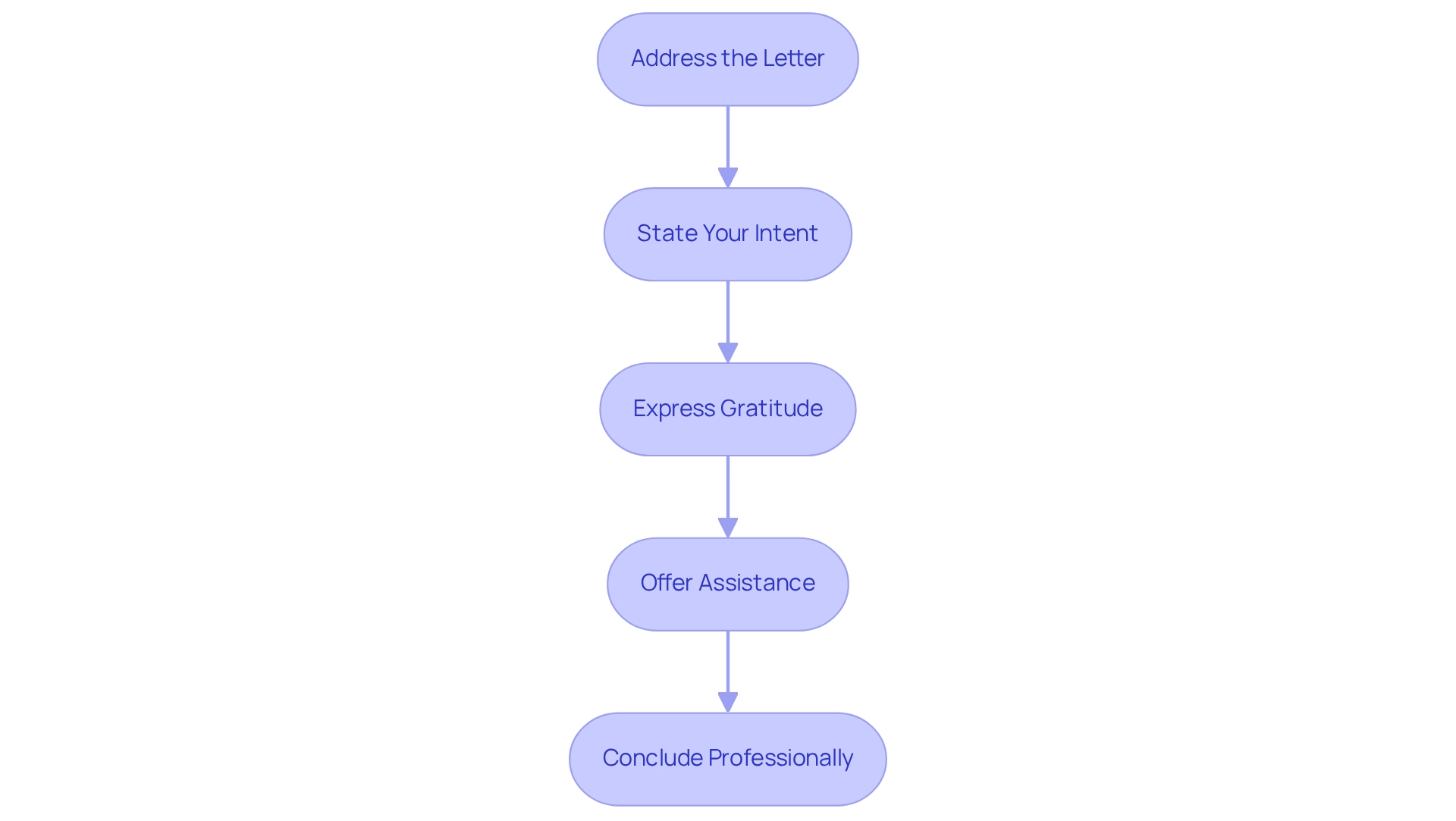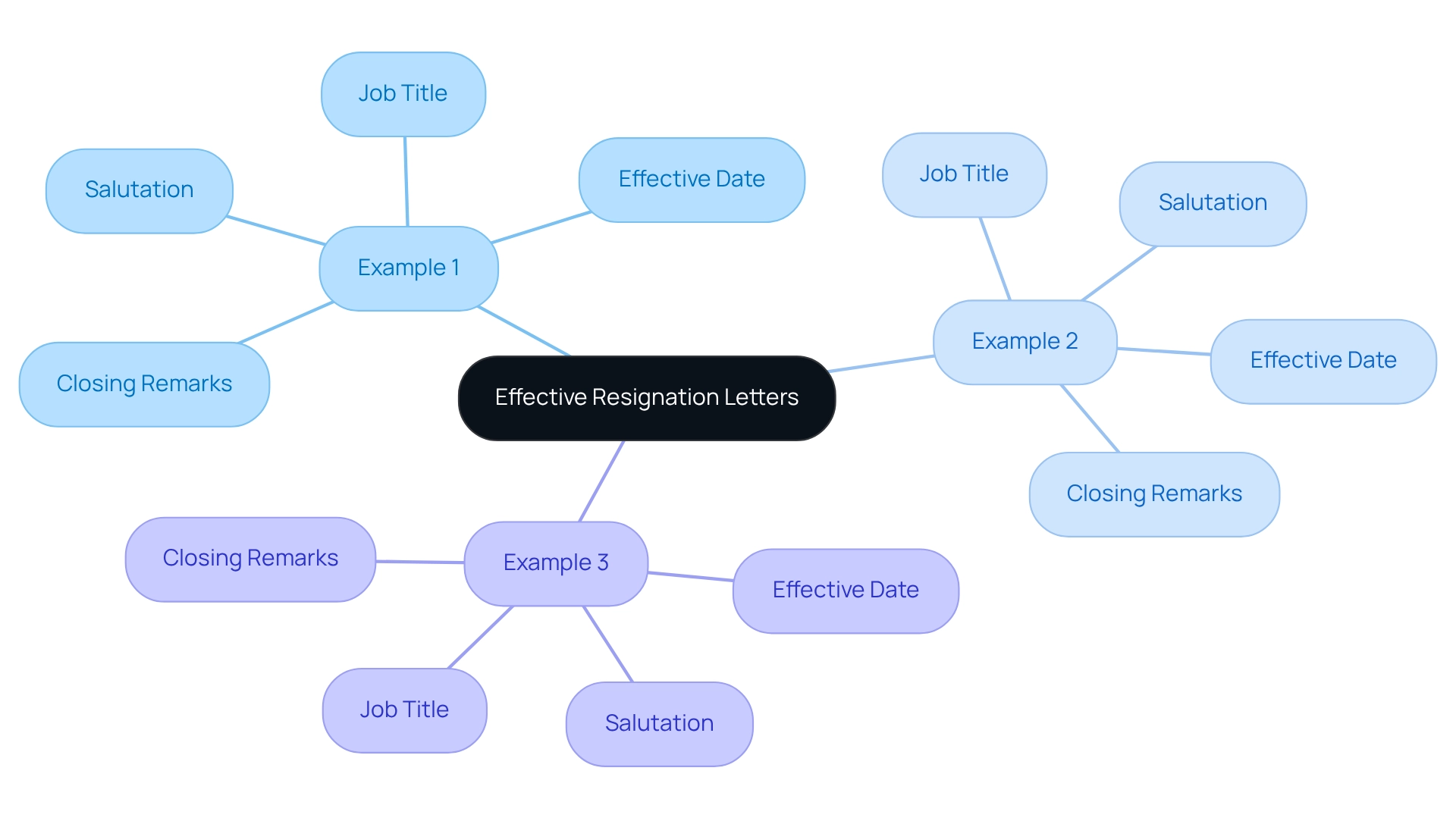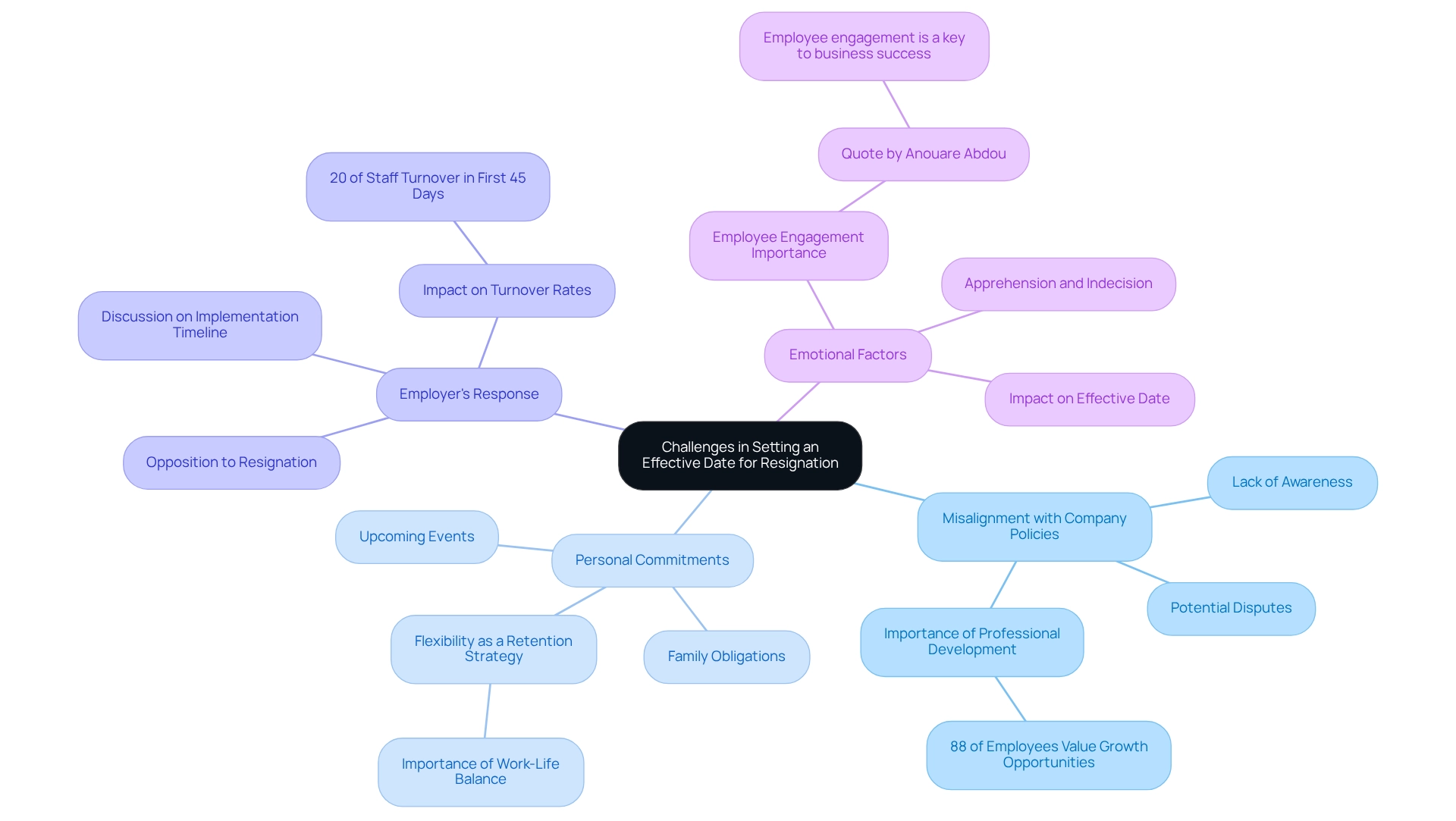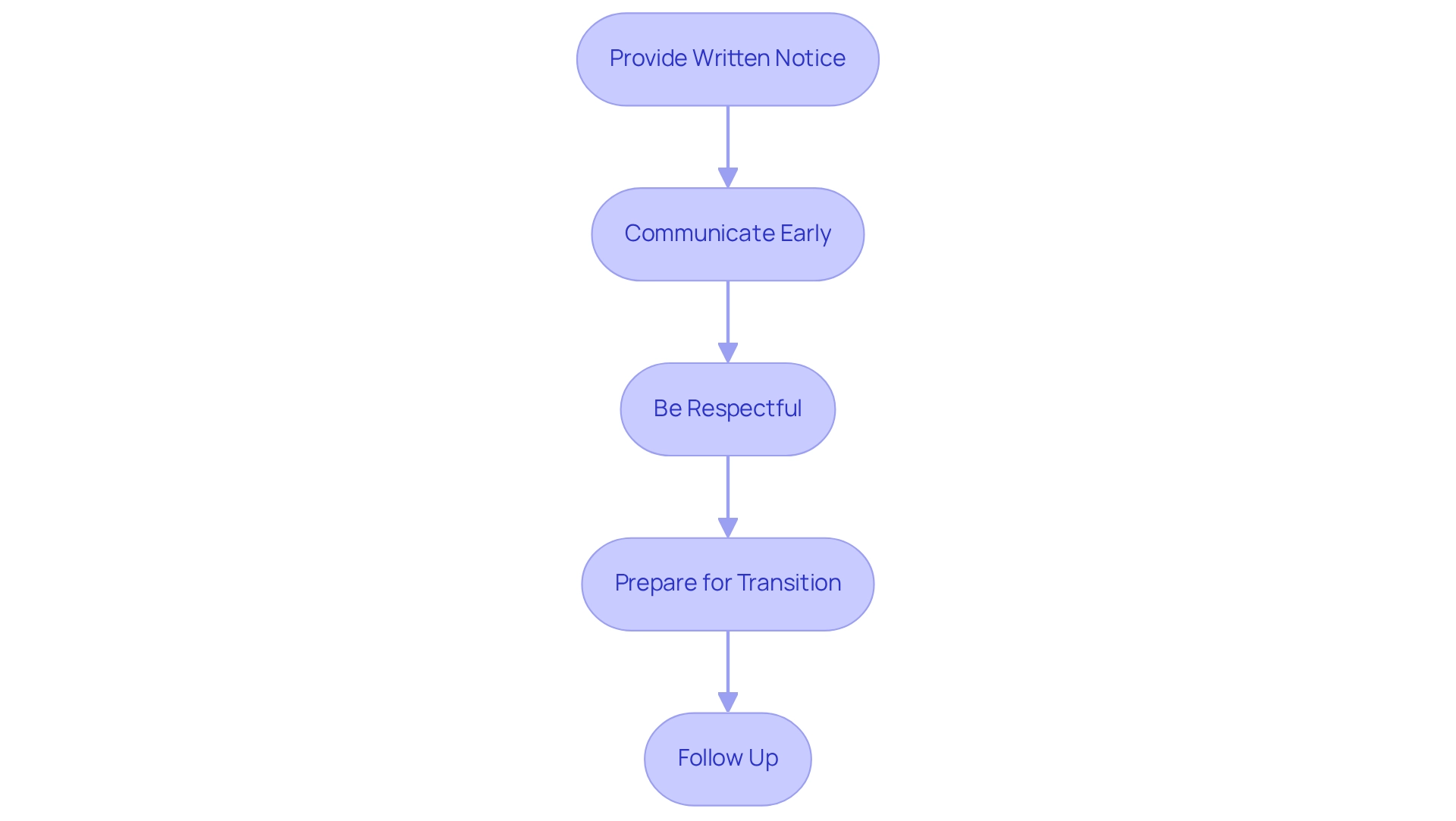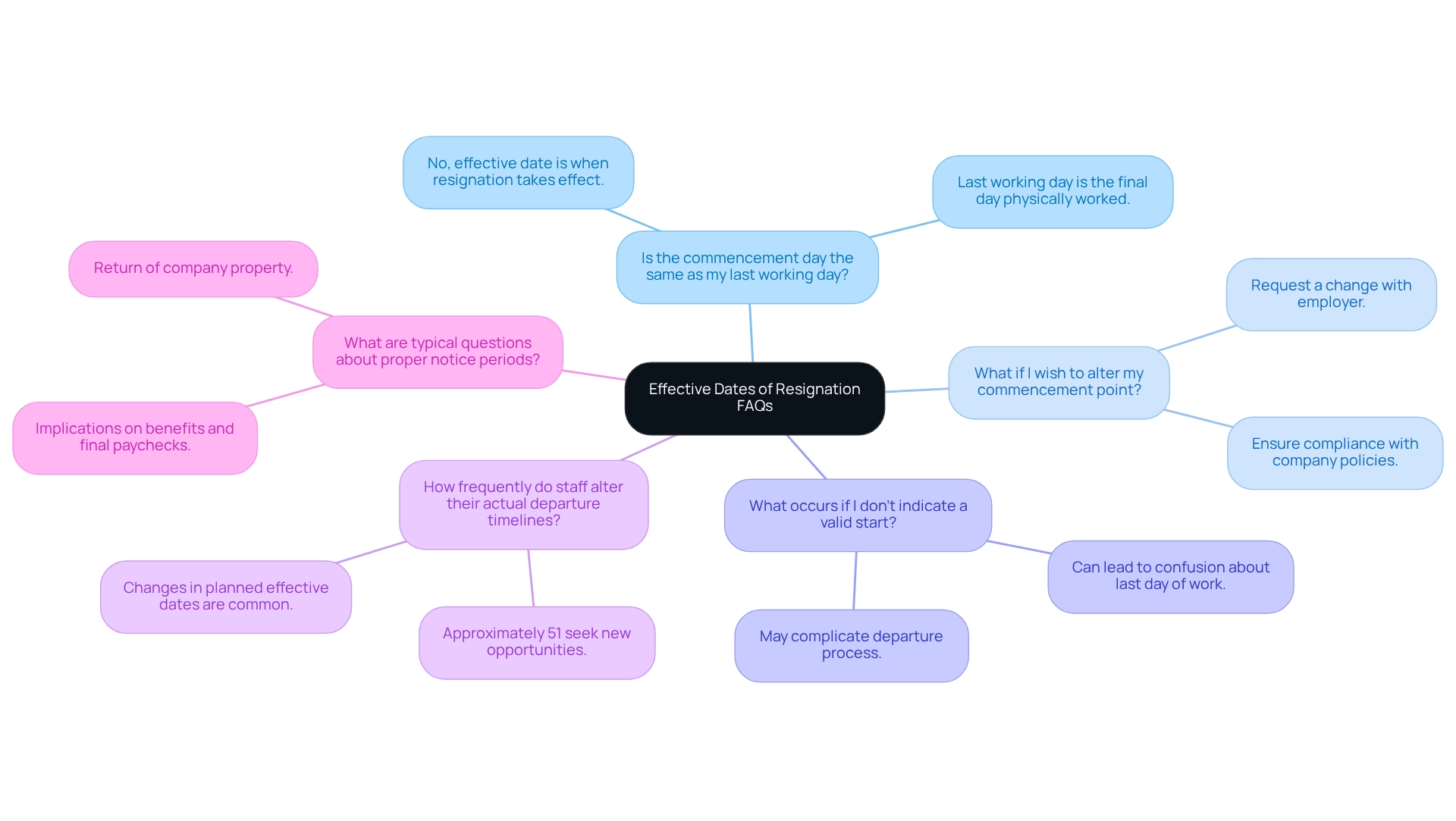Overview
The effective date of resignation is paramount for establishing clarity between employees and employers. This date is distinct from the last working day and plays a crucial role in managing staffing transitions smoothly. Clear communication of this date in resignation letters is essential. By emphasizing its importance, supported by statistical insights and expert opinions, organizations can mitigate misunderstandings and facilitate a professional departure process.
Key Highlights:
- The effective date of resignation is distinct from the last working day, and is crucial for clarity between employer and employee.
- 53.7% of employees in larger companies specify their effective resignation dates in letters, highlighting the need for clear communication.
- Organizations with defined departure protocols experience smoother transitions during staff turnover.
- Expert insights suggest that a well-defined resignation timeline aids in managing staffing needs and employee duties.
- Competitive pay and external job offers significantly influence an employee’s decision to resign.
- Best practices for writing a resignation letter include stating intent, specifying the effective date, and expressing gratitude.
- Challenges in setting an effective resignation date include misalignment with company policies, personal commitments, and emotional factors.
- Providing written notice and communicating early are essential for maintaining professionalism during the resignation process.
Introduction
Navigating the resignation process can be a daunting task for employees, particularly when it comes to establishing an effective date of resignation. This seemingly straightforward detail plays a pivotal role in ensuring clarity and professionalism during a transition that can often be fraught with uncertainty.
As organizations grapple with high turnover rates and the complexities of workforce management, the importance of a clearly defined resignation date becomes increasingly evident. This article delves into the nuances of effective resignation dates, exploring their significance for both employees and employers, best practices for crafting resignation letters, and strategies for minimizing misunderstandings.
By understanding the intricacies of this critical aspect of career transitions, individuals can leave their positions on amicable terms while preserving their professional relationships.
Defining the Effective Date of Resignation
The commencement moment of departure signifies the effectivity date of resignation, which is formally acknowledged and distinct from the worker’s last working day. This date, explicitly mentioned in the letter of departure, is crucial for both the employer and the worker, ensuring clarity regarding the conclusion of employment and any outstanding responsibilities. Misinterpretations of this timeline can lead to complications, such as payroll issues or uncertainty about the staff’s availability for transition tasks.
In HR practices, indicating the effectivity date of resignation is paramount. A recent study revealed that 53.7% of workers in companies of size classes 4, 5, and 6 clearly state their official departure times in their letters. This statistic underscores the importance of clear communication during the departure process and highlights the necessity for organizations to establish protocols that promote this clarity.
Moreover, case studies have shown that organizations with well-defined departure protocols experience smoother transitions. For example, a historical analysis of quit rates indicates that while current rates are elevated, they are not unprecedented. Understanding these trends can empower HR professionals to anticipate and manage turnover more effectively.
This historical context provides essential perspectives on how present patterns of leaving may evolve. Expert opinions further emphasize the significance of the effectivity date of resignation. HR specialists assert that a well-defined timeline aids in organizing staffing requirements and ensures that the departing staff member’s duties are effectively managed. Additionally, a 1-percent rise in hourly wages correlates with a 0.28 percent decrease in the quits rate, suggesting that competitive pay can influence turnover trends.
As highlighted by researcher Tae Heon Lee, unsolicited proposals from rival employers in competitive labor markets are also significant factors influencing a worker’s decision to resign.
In conclusion, the effectivity date of resignation transcends mere formality; it plays a vital role in the overall management of staff transitions. By ensuring mutual consent to this timeline, organizations can mitigate potential disruptions and maintain operational continuity. Furthermore, understanding retention rates—calculated by dividing the number of staff at the end of a period by the number at the start, then multiplying by 100—can further assist in managing transitions and comprehending turnover.
The Importance of an Effective Date in Resignation Letters
It is essential to include the effectivity date of resignation in a resignation letter to ensure clear communication between the worker and employer. This moment not only expresses the worker’s intentions but also establishes a clear effectivity date of resignation for the employer to manage the transition efficiently. When a valid timeline is omitted, confusion regarding the worker’s departure can arise, potentially complicating issues related to final compensation, benefits, and the handover of duties.
Such clarity regarding the effectivity date of resignation is crucial for upholding professionalism and ensuring that both parties share aligned expectations.
Expert insights emphasize that stating a valid timeframe, such as the effectivity date of resignation, can significantly minimize employer uncertainty. A study demonstrated that the correlation coefficient for the connection between pay and quit rates across sectors was −0.64 when sectors were not weighted and −0.69 when weighted, suggesting that transparency in departure processes can influence staff retention. Moreover, the absence of a clear timeframe regarding the effectivity date of resignation can exacerbate uncertainties, as employers may struggle to prepare for staffing adjustments without a definite schedule.
As one respondent noted, “What’s keeping me from answering a firm ‘Yes’ to this question is that I have concerns about whether they can or will make good on the offer.” This sentiment underscores the significance of transparency in departure processes, reflecting the concerns individuals may harbor regarding their job stability and future prospects.
Case studies illustrate the importance of timely information in resignation letters. For instance, following executive directives that altered job security perceptions among federal workers, many reported feeling anxious about their positions. This anxiety prompted some to consider resigning, highlighting the necessity for clear communication concerning the effectivity date of resignation to facilitate smoother transitions.
Future research should delve into the reasons behind the rise in quit rates, including demographic factors and the outcomes for workers who resign.
To compose a letter of departure that specifies the effectivity date of resignation, staff members should adhere to a straightforward format: begin with a formal salutation, indicate the desire to leave, specify the effectivity date of resignation, and convey appreciation for the opportunities afforded. For example:
Dear [Manager’s Name],
I am writing to formally resign from my position at [Company Name], effective [Effective Date]. I appreciate the support and opportunities I have received during my time here.
Thank you for your understanding.
Best regards,
[Your Name]
HR experts assert that clarity in resignation processes not only aids in maintaining professionalism but also fosters a positive relationship between the departing employee and the employer. By ensuring that departure letters specify the effectivity date of resignation and a clear timeline, organizations can mitigate uncertainty and promote a more orderly transition.
How to Determine Your Effective Date of Resignation
Determining your effective date of resignation requires careful consideration of several key factors:
- Notice Period: Start by reviewing your employment contract to understand the required notice period. Typically, in the U.S., this is two weeks; however, variations exist based on the company and the role.
- Company Policies: Familiarize yourself with your organization’s specific guidelines regarding departures and notice periods. Many organizations have established protocols that dictate how departures should be managed, potentially influencing your effective resignation date. As Amanda Chadwick advises, preparing for any changes in employment law that may impact these policies is essential.
- Personal Circumstances: Reflect on your individual situation, including any upcoming commitments or the start of a new job. These elements can affect your capacity to fulfill the notice period and should be weighed in relation to your resignation’s effective date. If you believe your dismissal was handled unfairly, consulting legal counsel may be prudent.
- Employer’s Needs: If feasible, engage in a dialogue with your employer regarding your departure. Identifying a mutually agreeable timeline can help maintain a positive relationship and ensure a smoother transition for both parties.
- Compliance with Notice Periods: Statistics reveal that 33% of individuals value appreciation from colleagues, underscoring the significance of adhering to notice periods. Compliance reflects professionalism and cultivates goodwill within the workplace.
- Industry Variations: Different industries exhibit varying norms regarding notice periods. For example, sectors with high turnover rates, such as retail or hospitality, often have shorter notice periods compared to more specialized fields like finance or healthcare.
- Case Studies: Analyzing case studies, such as “The Rise of Counter Offers,” illustrates that while immediate financial incentives may be appealing, they frequently fail to address the underlying reasons for an employee’s departure. Understanding these dynamics can inform your decision on the appropriate timeline, as counter offers may complicate your exit process.
By considering these elements, you can make an informed decision regarding the effective date of your resignation, ensuring that you leave your role on favorable terms while preparing for your next career step.
Crafting a Resignation Letter with an Effective Date
When preparing your departure letter, it’s essential to follow a structured approach to ensure clarity and professionalism. Here are the key steps to consider:
-
Address the Letter: Begin with a formal greeting, such as ‘Dear [Manager’s Name]’. This sets a respectful tone for your communication.
-
State Your Intent: Clearly announce your resignation and indicate the start date. For example, you could say, ‘I am writing to formally resign from my position, starting [Date].’ This clarity helps avoid any misunderstandings regarding your departure.
-
Express Gratitude: Take a moment to thank your employer for the opportunities and experiences you have gained during your tenure. Acknowledging your time at the company fosters goodwill and maintains a positive relationship.
-
Offer Assistance: If appropriate, offer to assist with the transition process. This could include training a replacement or wrapping up ongoing projects, demonstrating your commitment to a smooth handover.
-
Conclude Professionally: End your letter with a polite closing, such as ‘Sincerely’ or ‘Best regards’, followed by your name. This reinforces your professionalism and leaves a positive impression.
Sample Resignation Letter Template:
[Your Name]
[Your Address]
[Your City, State, Zip]
[Date]
[Manager’s Name]
[Job Title]
[Company Name]
Dear [Manager’s Name],
I am writing to formally resign from my position, effective [Date]. I want to express my gratitude for the opportunities and experiences I have gained during my time at [Company Name]. I appreciate your support and guidance throughout my tenure.
If possible, I would be happy to assist in the transition process to ensure a smooth handover of my responsibilities.
Thank you once again for everything.
Sincerely,
[Your Name]
Understanding the effective date of your resignation is crucial, as it can impact both your future employment opportunities and the organization’s planning. For instance, a study showed that 88% of workers who departed their positions stated they would have remained if provided better benefits, emphasizing the significance of transparent communication during the departure process. As McKinsey states, ‘If you communicate effectively with your staff, you can enhance their productivity.’
Moreover, difficulties in establishing an appropriate effective date of resignation can emerge from discussions with employers, personal obligations, and company regulations. The case study titled ‘Challenges in Setting an Effective Date’ illustrates these complexities, emphasizing the need for staff to navigate the departure process thoughtfully. By being aware of these factors, employees can ensure that both their needs and those of the employer are considered.
Integrating these best practices into your departure letter will not only facilitate a smoother transition but also enhance your professional reputation as you advance in your career.
Examples of Resignation Letters Featuring Effective Dates
Effective communication is paramount when resigning from a position, particularly in today’s competitive job market. Here are several examples of resignation letters that include effective dates, showcasing best practices:
-
Example 1:
“Dear [Manager’s Name], I am writing to formally resign from my position as [Job Title], effective [Date]. I appreciate the opportunities I have had at [Company Name] and wish the team continued success. Thank you for your understanding.
Sincerely, [Your Name].”
-
Example 2:
“Dear [Manager’s Name], Please accept this letter as my formal resignation from [Job Title], effective [Date]. I am grateful for the support and guidance I have received during my time here. I am happy to assist in the transition process.
Best regards, [Your Name].”
-
Example 3:
“Dear [Manager’s Name], I am writing to inform you of my resignation from [Job Title], effective [Date]. I have enjoyed working with you and the team and appreciate all the opportunities provided to me. Thank you for everything.
Sincerely, [Your Name].”
These examples illustrate the significance of defining an effective resignation date, which can help alleviate common challenges related to departure procedures. Employees often face difficulties in aligning their departure with company policies, particularly in a competitive job market where job openings are predicted to rise by 2.9 percent. Clear communication regarding the effective date of resignation can mitigate potential misunderstandings.
As Dan Holdsworth pointed out, assumptions regarding uniformity among workers may overlook individual predispositions towards job mobility, making it essential for individuals to communicate their intentions clearly. Moreover, a case study contrasting quit rates in manufacturing with the overall economy suggests that comprehending trends in departure behavior can offer valuable insights for HR managers. By establishing a clear starting point, staff can facilitate a smoother transition and uphold professional relationships.
Challenges in Setting an Effective Date for Resignation
Setting an effective date for resignation presents several challenges that employees must navigate:
- Misalignment with Company Policies: Employees often lack awareness of their organization’s specific policies regarding notice periods. This oversight can lead to misunderstandings and disputes, particularly if the effective date of resignation does not align with the company’s expectations. With 88% of staff considering professional development and career growth opportunities important when evaluating potential employers, understanding these policies is crucial for making informed decisions about timing.
- Personal Commitments: The decision to resign is frequently influenced by personal commitments, such as family obligations or upcoming events. Balancing these personal factors with professional duties complicates the timing of a departure, making it essential for individuals to carefully consider their overall situation, including the effective date of resignation. The case study titled ‘Flexibility as a Retention Strategy’ highlights how providing flexible work options can affect a worker’s choice to resign and the timing of that resignation.
- Employer’s Response: Workers may face opposition from employers who wish to discuss the implementation timeline, particularly when the staff member occupies a vital role within the organization. This pushback creates tension and uncertainty, making it vital for employees to prepare for potential discussions about their effective date of resignation. Notably, the first 45 days of a new hire account for up to 20% of staff turnover, emphasizing the importance of timing in relation to turnover rates.
- Emotional Factors: Resigning is often an emotional process, filled with apprehension and second-guessing. Employees may struggle with the decision, leading to indecision about when to formally resign. This emotional turmoil affects their capacity to establish a clear and effective effective date of resignation. As Anouare Abdou states, “Employee engagement is a key to business success,” highlighting the significance of addressing these emotional factors during the departure process.
Comprehending these challenges is vital for individuals seeking to resign in a professional and effective manner. By being aware of potential pitfalls, they can better prepare for a smooth transition. Furthermore, with 46% of high-achieving workers actively looking for improved job prospects, the importance of establishing a suitable departure time cannot be emphasized enough.
Best Practices for Resigning with an Effective Date
To resign professionally with an effective date, it is essential to adhere to the following best practices:
- Provide Written Notice: Always submit a formal departure letter to clearly document your intent. This serves as an official record of your choice and the effectivity date of resignation.
- Communicate Early: Aim to give your employer as much notice as possible. This not only demonstrates respect but also allows for a smoother transition, which is crucial in maintaining positive relationships within the workplace. Boutique Recruiting’s impressive track record of success highlights the importance of fostering these relationships, as they can lead to future opportunities.
- Be Respectful: Maintain a positive tone in your resignation letter and during discussions with your employer. A respectful approach can help preserve your professional reputation and may benefit you in future endeavors. As Jeremy Pollack, Principal at Pollack Peacebuilding Systems, notes, “Research has shown how important confidentiality is to an effective resolution process.” This underscores the need for discretion when resigning.
- Prepare for Transition: Offer to assist in training a replacement or wrapping up ongoing projects. This proactive step can leave a lasting positive impression and facilitate a seamless handover of your responsibilities. For instance, Marsh McLennan’s implementation of digital tools for employee well-being has shown that maintaining a positive workplace culture can enhance productivity and satisfaction, benefiting both the employer and the employee during transitions.
- Follow Up: After submitting your notice, follow up with your manager to discuss the transition plan and any remaining responsibilities. This ensures clarity and demonstrates your commitment to a smooth exit.
Understanding the effectivity date of resignation is vital, as it can influence both your present employer and your future prospects. Misunderstandings regarding resignation timelines often result in confusion; for example, many think that a verbal resignation is enough, but a written notice is crucial for clarity and professionalism. Additionally, research indicates that disengaged managers cost the U.S. economy between $77 billion and $96 billion annually.
By resigning respectfully and effectively, employees can help mitigate these costs and ensure a positive outcome for all parties involved.
Frequently Asked Questions About Effective Dates of Resignation
Here are some frequently asked questions regarding effective dates of resignation:
-
Is the commencement day the same as my last working day?
No, the effective date refers to when your resignation officially takes effect, while your last working day is the final day you physically work before that effective date. Clarifying this distinction is crucial to avoid misunderstandings with your employer. -
What if I wish to alter my commencement point?
You can request a change to your effective date, but it’s essential to discuss this with your employer. Ensure that any adjustments comply with company policies and facilitate a smooth transition, as changes can impact project timelines and team dynamics. -
What occurs if I don’t indicate a valid start?
Not specifying an effective date can lead to significant confusion regarding your last day of work. This oversight may complicate the departure process, potentially resulting in misunderstandings about your availability and responsibilities. A recent study emphasized that 64% of workers are considering leaving their positions, underscoring the importance of clear communication during this critical transition. With 52% of staff intending to pursue new job prospects in 2023—an increase from 37% the prior year—the demand for clarity in departure processes is more urgent than ever. -
How frequently do staff alter their actual departure timelines?
Statistics indicate that a notable percentage of employees, approximately 51%, actively seek new opportunities, often leading to changes in their planned effective dates. This trend highlights the need for clarity and flexibility in the departure process. -
What are typical questions about proper notice periods?
Employees frequently inquire about the implications of their effective date on benefits, final paychecks, and the return of company property. Proactively addressing these questions can help mitigate potential issues and ensure a smoother exit.
As Ryan Bradshaw notes, “Mindfulness means slowing down enough to be thoughtful about what you’re doing. It brings more self-awareness of how you feel, how you speak, and…” Understanding these aspects of effective resignation dates is crucial for both employees and employers, particularly in a competitive job market where many are considering new opportunities. By fostering open communication and clarity, organizations can better manage transitions and retain valuable talent.
Conclusion
Establishing an effective date of resignation is a critical step in ensuring a professional and smooth transition for both employees and employers. By clearly defining this date in a resignation letter, employees communicate their intentions while aiding employers in managing staffing needs and transition plans effectively. The importance of specifying an effective date cannot be overstated; it mitigates misunderstandings that can lead to complications regarding final pay, benefits, and the transfer of responsibilities.
Navigating the resignation process requires careful consideration of various factors, such as notice periods, company policies, and personal circumstances. Are you aware of these elements? By understanding them, employees can make informed decisions that benefit both themselves and their employers. Moreover, implementing best practices when crafting resignation letters—such as expressing gratitude and offering assistance during the transition—fosters goodwill and maintains positive professional relationships.
As the workforce continues to evolve, understanding the dynamics of resignation and effective dates becomes increasingly vital. With high turnover rates and competitive job markets, clear communication and a thoughtful approach to resignations are essential. By prioritizing these elements, individuals can leave their positions on amicable terms, paving the way for future opportunities while preserving their professional reputations. Ultimately, a well-managed resignation process not only benefits the departing employee but also supports the organization in maintaining operational continuity.
Frequently Asked Questions
What is the effectivity date of resignation?
The effectivity date of resignation is the official date when a worker’s resignation takes effect, as stated in their resignation letter. It is crucial for both the employer and the employee to ensure clarity regarding the end of employment and any remaining responsibilities.
Why is it important to include the effectivity date in a resignation letter?
Including the effectivity date in a resignation letter ensures clear communication between the worker and employer, helping to manage transitions efficiently and avoid confusion regarding final compensation, benefits, and the handover of duties.
What complications can arise from misinterpreting the effectivity date?
Misinterpretations of the effectivity date can lead to payroll issues, uncertainty about the employee’s availability for transition tasks, and complications in managing staffing adjustments.
How prevalent is the practice of stating the effectivity date in resignation letters?
A study revealed that 53.7% of workers in certain company size classes clearly state their official departure times in their resignation letters, highlighting the importance of clear communication during the departure process.
What benefits do organizations gain from having well-defined departure protocols?
Organizations with well-defined departure protocols experience smoother transitions and can better manage staffing requirements, ensuring that the departing employee’s duties are effectively handled.
How can competitive pay influence turnover trends?
Research indicates that a 1-percent rise in hourly wages correlates with a 0.28 percent decrease in the quits rate, suggesting that competitive pay can impact employee retention.
What factors influence a worker’s decision to resign?
Unsolicited proposals from rival employers in competitive labor markets are significant factors influencing a worker’s decision to resign, along with other personal and professional considerations.
How can organizations calculate retention rates?
Retention rates can be calculated by dividing the number of staff at the end of a period by the number at the start, then multiplying by 100, providing insights into managing transitions and understanding turnover.
What should a resignation letter include to specify the effectivity date?
A resignation letter should include a formal salutation, a statement of the desire to leave, the specified effectivity date of resignation, and an expression of appreciation for the opportunities received.
What is the overall significance of the effectivity date of resignation?
The effectivity date of resignation is vital for managing staff transitions, as it ensures mutual consent to the timeline, helps mitigate potential disruptions, and maintains operational continuity.
